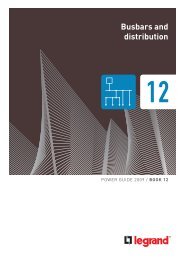Create successful ePaper yourself
Turn your PDF publications into a flip-book with our unique Google optimized e-Paper software.
5<br />
38<br />
THE GROUP’S BUSINESS<br />
<strong>Legrand</strong>’s business<br />
<strong>Legrand</strong>’s market also offers medium-term natural growth<br />
potential linked to increasing interest in high added-value<br />
products, with a focus on both functionality (new features and<br />
ease of use) and aesthetic features in an approach referred to as<br />
“trading up”. For example, the successful commercial release of<br />
Céliane in France and its high-end product line Axolute in Italy,<br />
combining wiring devices, access control and home automation,<br />
had a very positive effect on <strong>Legrand</strong>’s sales. By way of illustration,<br />
the “trading up” effect contributed to 23% of revenue growth in<br />
France and Italy in <strong>2007</strong>.<br />
In addition, <strong>Legrand</strong> sees strong growth potential in integrated<br />
systems and high added-value products in the United States<br />
(home automation systems, energy saving systems and highend<br />
lighting control), where the combined revenues of OnQ,<br />
specialized in structured cables for housing, The Watt Stopper, the<br />
No. 1 player in high-effi ciency lighting control in the commercial<br />
sector, and Vantage, No. 2 in high-end residential lighting control,<br />
increased by 22% in <strong>2007</strong> (at constant exchange rates).<br />
Emerging markets<br />
Moreover, in emerging markets such as Brazil, China, India,<br />
Mexico and Russia, the constant development of electrical<br />
infrastructure and data networks creates demand for both lowand<br />
high-end products. Notably, in E astern China, the market<br />
for high-end products represents approximately 30% of the total<br />
market. Finally, as nearly one-fourth of the world’s population<br />
does not yet have access to electricity, <strong>Legrand</strong> believes that<br />
the market offers significant long-term growth potential as<br />
such access is provided. In <strong>2007</strong>, net sales in emerging markets<br />
represented nearly 25% of the Group’s total revenues.<br />
Energy effi ciencys<br />
Electricity now accounts for 70% of energy consumption in<br />
buildings (source: <strong>2007</strong> Building Energy Data Book ). This is<br />
associated with growing demand on all <strong>Legrand</strong>’s markets for<br />
products and systems reducing energy consumption, together<br />
with related environmental impact, and improving the quality<br />
of electricity.<br />
<strong>Legrand</strong> does so with a comprehensive range of solutions for<br />
home automation and the control of lighting, electric shutters, hot<br />
water supply, and equipment in standby mode. <strong>Legrand</strong> solutions<br />
also enable customers to optimize the quality of electric current<br />
through source inversion, compensation of reactive energy,<br />
energy-effi cient transformation, and surge protection.<br />
Sales of energy-effi cient solutions accounted for approximately<br />
5% of <strong>Legrand</strong>’s consolidated total in <strong>2007</strong>, showing a year-onyear<br />
rise of 27% at constant scope of consolidation and exchange<br />
rates.<br />
REFERENCE DOCUMENT <strong>2007</strong> - legrand<br />
< Contents ><br />
■ 5.1.2.4 - FRAGMENTED MARKET<br />
The accessible market remains highly fragmented, as <strong>Legrand</strong><br />
estimates that approximately 50% of worldwide net sales are<br />
made by often local, small- and medium-sized companies who<br />
typically enjoy only marginal worldwide market share. With<br />
an estimated accessible market share on the order of 7% in<br />
<strong>2007</strong>, <strong>Legrand</strong> believes it is a leader in, and a benchmark for,<br />
the market. Market fragmentation is due in part to differences<br />
between countries’ applicable technical standards and norms<br />
and also to the various customs of the end-users in each<br />
country. Historically, initiatives to harmonize standards in<br />
order to make products able to be used worldwide have failed,<br />
even within the European Union, notably due to the signifi cant<br />
investment necessary to replace existing electrical networks for<br />
only limited added-value. Consequently, a signifi cant portion of<br />
the market for products and systems for low-voltage electrical<br />
installations and data networks remains traditionally in the hands<br />
of local, modestly sized manufacturers. The acquisition of these<br />
manufacturers may offer growth opportunities.<br />
■ 5.1.2.5 - FAVORABLE PRICE TRENDS<br />
The market is globally characterized by a relative lack of<br />
4<br />
commoditization. Electrical professionals, specifi ers and endusers<br />
pay special attention to products’ technical characteristics,<br />
without necessarily considering price as the determining factor.<br />
5<br />
Therefore, as an example, electrical professionals tend to favor<br />
products that can be effi ciently used (quality, reliability, ease and<br />
speed of installation, compatibility with related products, long-<br />
6<br />
term product availability, commercial and technical assistance,<br />
safety) and that offer characteristics demanded by end-users<br />
7<br />
(functionality, aesthetics, ease of use).<br />
According to a survey conducted by Sonepar, a French electrical<br />
8<br />
equipment distributor, in terms of electrical installers’ priorities,<br />
price was ranked seventh behind quality, delivery time, availability,<br />
on-time response to requirements, product <strong>document</strong>ation and<br />
9<br />
ease of installation.<br />
Whereas certain industries can be characterized by falling prices<br />
10<br />
for products, <strong>Legrand</strong>’s accessible market shows a different<br />
overall trend. The production and distribution value chain for<br />
<strong>Legrand</strong>’s products benefits from an established ability to<br />
11<br />
increase sales prices regularly over the long term. Moreover,<br />
end-user sensitivity to product prices is mitigated by the fact<br />
that electrical installations (excluding cables and cost of labor)<br />
12<br />
generally represent around 5% of the total cost of an average new<br />
commercial or residential construction project. Between 1992<br />
13<br />
and <strong>2007</strong>, <strong>Legrand</strong>’s selling prices have increased on average by<br />
1.7% per year globally in its markets. Moreover, <strong>Legrand</strong> has a<br />
degree of control over its prices, due to its strong market position<br />
CT<br />
and its ability to develop and offer innovative products.<br />
A<br />
1<br />
2<br />
3








